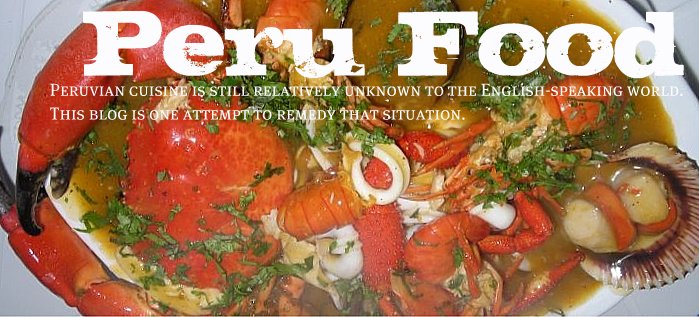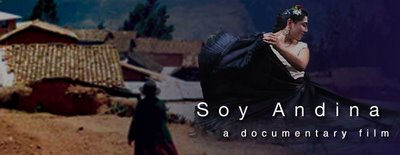
Soy Andina is a documentary, "the dazzling story of two New York women raised in different worlds, an immigrant folk dancer from the Andes and a modern dancer from Queens who return to Peru in search of roots and dance." Still in post-production, the film has many people eagerly waiting for distribution, myself included.
The story is simple, yet moving:
"After 15 years in New York, Nelida Silva returns to her birthplace in the Andes to fulfill a lifelong dream and host (her village's annual fiesta) -- an astonishing week of dance, music, and ritual. But Nelida has changed, and so has the village. What is it like to go back to the Andes when you've become a New Yorker?
Two years later: Cynthia Paniagua, a dancer raised in Queens by a Peruvian mom, embarks on her own Peruvian journey after meeting Nelida determined to "quench a burning desire to know the real Peru, to unearth the mystery of the dances." Does she find what she's looking for?"
Of course, you have to see the movie to find out the answer.

A few days back, I received an e-mail from the filmmaker, Mitch Teplitsky, who told me that he has been a regular visitor to this blog, and had listed Peru Food as one of his favorite blogs in English about Peru. I was beyond flattered. And, ironically, I had been visiting his website regularly, waiting to find out when Soy Andina will finally be released.
As a child, Mitch lived in Peru. He has known Nelida Silva for the last 15 years. And like many others, he is a dedicated fan of Peruvian cuisine.
 Mitch Tiplitsky getting ready to sample some Peru Food.
Mitch Tiplitsky getting ready to sample some Peru Food.
Visit the Soy Andina website and Mitch's weblog to find out more about this extraordinary project.
Peru.Food@gmail.com
.
.
.
Braunwarth's post about wanting to eat cuy, or guinea pig, in Peru got me thinking and researching. This is what I found.
A 2004 article in the British magazine, The Economist, discussed the development of a super cuy in the Cajamarca lab of Peru's National Agrarian Research Institute.
No, this guinea pig doesn't have supernatural powers nor does it battle evil forces in the world.
Instead, the term super-cuy or mega-cuy refers to the size of the cuyes being raised.
In July 2004, scientists "launched a new super cuy, as it is known in Peru, weighing up to three kilos" or seven pounds.
In The Economist: A Guinea Pig For All Tastes and Seasons, the author details how researchers in Peru hope the larger-sized cuyes will improve the diet of the poorest Peruvians.
Cuy is richer in protein, and contains less fat, than either chicken, pork, or beef. One cuy can easily feed a family of four.
Ironically, prior to the arrival of the Spanish, cuyes were much larger than the current breeds available in Peru. This delicacy was a key protein source for Andean people for the past 5,000 years. Cuyes were so important to the well-being of Andean society, that one Inca saying exhorts, "Raise guinea pigs and eat well".
Sadly, the farming of guinea pigs was relegated by the arrival of Europeans and new sources of meat, such as beef and pork. After colonization, eating cuy was considered backward, although people in the Andes still raised and ate them, mostly for special occasions. No Andean fiesta is complete without a cuy being brought out for revelers to enjoy.
According to The Economist, Peruvians were consuming 22 million guinea pigs a year. Researchers hope to increase that quantity by encouraging diners to think of cuy not only as a dish to be served at festivals or parties, but as an everyday type of food.
Cuy is often described as tasting like rabbit. As The Economist's writer points out, "The main drawback of guinea pig is that it has rather a lot of small bones for not much flesh. Science may at last have changed that."
To help Peruvians, and other intrepid cooks, think of new and innovative ways to prepare this ancient Andean food, the National Agrarian Research Institute has developed a list of recipes (which include cuy in peanut sauce, cuy in wine, and cuy brochettes, among others). More on these recipes later.
Peru.Food@gmail.com
.
.
.
Braunwarth, a university professor from California, was recently traveling around Peru with three generations of his family.
In a recent post on his blog, Escape From Reality: The Foods of Cuzco, Braunwarth writes about his experience with Peruvian food in Cuzco.
He categorically states, "One of the great things about Cusco is the food."
Braunwarth uses the Spanish spelling for Cuzco. There is also a Quechua spelling, Qosqo.
In Cuzco, he notes, "the traditional Peruvian restaurants, generally on or near the Plaza de Armas ... serve set prices menus of a soup, a main course, and a drink or dessert for around $3-7." There are also "funkier, hip restaurants scattered around the historic center" popular with tourists.
But, he also notes that to experience the "real Peru", a visitor has to eat at the local "Picanterias, Cevicherias, Cuyerias, and Chicharronerias". These are all traditional restaurants specializing in one specific dish or cuisine. Faced with all the pizzerias and roast chicken places in Cuzco, he concludes, "it kind of defeats the purpose of going to a foreign country if you are going to eat the same food you can get in the U.S."
Like most travelers to Peru, Braunwarth was fascinated at the thought of sampling an Andean delicacy: cuy, or guinea pig. He writes, "Of first item of interest is, of course, Cuy or roasted guinea pig." After sampling roast cuy, he says, "I have to admit that I really liked it although the skin can be a bit chewy and one has to put in a pretty workout with the incisors to get a decent amount of meet off of the little rodents." At his blog, he has great pictures of cuyes in various stages of the cooking process (not for the squemish).
 Cuyería, a restaurant specializing in cuyes or guinea pig.
Cuyería, a restaurant specializing in cuyes or guinea pig.
Photo by J. Braunwarth from Escape From Reality.
Braunwarth is also impressed by Andean corn: "The corn is worthy of mention itself. The kernels are huge and sweet and light yellow and ... usually served with the salty local cheese." He likes habas, a large bean served boiled, and the always-popular fried and salted corn kernels: "They're excellent with a glass of the local Cusqueña lager!"
He and his family enjoyed two types of fruit common in Peru, granadilla and chrimoya. About granadilla, he writes, "Once (you) break through the crunchy shell (you're) rewarded with a bunch of small seeds attached to each other by a kind of sweet viscous material. When you slurp down a glob, you get the interesting sensation of eating some that is sweet and smooth and crunchy all at the same time. With chirimoya, he says: "The flesh is sweet and fairly solid and surrounds big black seeds which you have to spit out as you eat."
 Granadilla on the left and chirimoya on the right.
Granadilla on the left and chirimoya on the right.
Photo by J. Braunwarth from Escape From Reality.
This is a family of adventurous eaters, willing to try new foods. Although light-years from the haute cuisine available in the posh Lima restaurants, these traditional eateries are also a great way to sample Peruvian food.
Visit Braunwarth's blog to read about his travels in Peru and view his pictures: Escape From Reality.
Peru.Food@gmail.com
.
.
.
Avenida Primavera forms the boundary between two middle-class Lima districts, San Borja and Santiago de Surco. Avenida Primavera is the continuation of Avenida Angamos Este, changing names when it crosses Caminos del Inca.
 The First Five Blocks of Avenida Primavera.
The First Five Blocks of Avenida Primavera.
This map shows where Avenida Angamos Este changes
name to become Avenida Primavera.Maps from Guía de Calles Lima y Perú 2006.
The ten blocks between Caminos del Inca and the Panamericana Sur have become a new culinary hotspot in Lima, with numerous dining options all of very good quality.
The following is an unofficial, informal translation of an article that appeared in El Comercio in January, 2006.
The Pleasure of the Palate
From El Comercio, 01/23/06.
Original article: El Comercio.
There's a new foodie corridor in Lima.
The area between San Borja and Santigo de Surco has become an unexpected garden of culinary delights for all tastes and budgets, home to some of Lima's best restaurants, pizzerias, bodegas, and cafes.
A tasting tour along Avenida Primavera is well-rewarded.
There is a restaurant to satisfy any craving or desire, whether it's breakfast, lunch, dinner, or even the intense pleasure of an afternoon lonche (Peruvian tea time).
 Pastelería San Antonio.
Pastelería San Antonio.
Photo: Oscar Roca in El Comercio.
Located along Avenida Primavera are some classic Lima restaurants, such as José Antonio, home of the best lomo saltado in the city. The pastry shop Pastelería San Antonio was one of the first establishments to arrive to this area now rich with culinary alternatives.
Tanta offers Gastón Acurio's delicacies at very reasonable prices. For pastas and desserts, Bodega de la Trattoria is simply spectacular. In the 600 block, we find the perfect cafe, Delicass, with its superb pastries and some of the best coffee in Lima.
 The incomparable desserts at Bodega de la Trattoria.
The incomparable desserts at Bodega de la Trattoria.
Photo: Germán Falcón in El Comercio.
For carnivores, the place to go is El Asador, where owners take rightful pride in their authentic Argentine asado. Or, close to the Caminos del Inca shopping center, the magnificient pizzeria Antica.
Finally, there are the pioneers, those first establishments to open in the area, such as the cafes Bocatta and Cherry, and the pastry-shop L'Hermitage (with their notable chicken fricassé empanadas and Gran Marnier truffels.)
Your table is waiting on Avenida Primavera.
Here is a list of some of the dining options along Avenida Primavera.
Antica Pizzeria
Avenida Primavera 275
Phone: 372-2698, 372-2792
Open daily 12 noon to 12 midnight.
Median price: Pizza from 22 to 39 soles.
Notes: Its pizzas (all large thin-crust) are superb. The best ones include the four cheese pizza (gongorzola, emmental, parmesan, mozarella), and the funghi and prosciutto pizza. You can also try fetuccini a la funghi i porcini, or the lomo a la pizzaiola (steak served with a pomodoro and mozarella sauce).
Bocatta
Primavera 311
Phone: 372-1426, 372-7445
Open Monday to Friday, 8 a.m. to 12 midnight. Saturday, 9 a.m. to 2 a.m.
Sunday, 9 a.m. to midnight.
Median price: 28 soles.
Note: They begin the day with special breakfast offers (all include juice and a hot beverage): choose from continental, American, Executive, French, or the Bocatta breakfast (with pancakes or French toast). Tea time begins at 4 p.m. and there are specials starting at S/.13,50 per person (a sandwich, a beverage and dessert). There is a lunch menu.
Pastelería San Antonio
Primavera 373
Phone: 372-7677, 372-7645
Open daily, 7 a.m. to 11 p.m.
Median price: 20 soles (full meal)
Note: This is a traditional eatery. All of the branches offer deli-style meats and cheeses, salads, sandwiches, fresh fruit juices, and ice cream. They also have coffee, pastries, and other desserts.
José Antonio
La Floresta 124, at the 500 block of Avenida Primavera
Phone: 372-6868, 372-7288
Open daily, 12:30 p.m. to 4:30 p.m. , and again from 7:30 to 12 midnight.
Sunday, lunch only.
Median price: 36 soles.
Note: This is a classic in the Lima restaurant scene specializing in Peruvian and International cuisine. The sampler plate, el piqueo José Antonio, and the lomo saltado José Antonio are stellar. They offer an excellent lunch buffet.
Delicass
Primavera 654
Phone: 372-5203
Open daily, 8 a.m. to 12 midnight.
Median price: 7 soles
Note: The hot and cold sandwich menu is extensive. Pastas are quite good. They also offer deliwraps (rolled sandwiches made with pita-style bread), quiches, pastries, empanadas, salads, juices, ice cream and a wide dessert list.
El Asador
Primavera 679
Phone: 372-2590
Open daily, 1 p.m. to 4:30 p.m., and again, 7:30 p.m. to 11:30 p.m.
Sunday closes at 5 p.m.
Median price: 45 soles.
Note: Specialties include meats like goat, roast suckling pig, beef, and potato soufflé Buenos Aires style. The double parilla includes chops, morcilla, chorizo, kidneys, chinchulines and gizzards, with two sides, for 66 soles.
T'anta
Primavera 692
Phone 372-3528
Open Monday to Friday 10 a.m. to 12 midnight. Saturday, 9 a.m. to 12 midnight. Sunday closes at 10 p.m.
Median price: 30 soles.
Note: Among the best options, the sandwich criollo (fine beef, onion, peppers and Dambo cheese), the tortilla madrileña, the stew with mushrooms, bacon and onion, green old-fashioned fetuccini, and for dessert, the banana manjar, maracuyá tart, and the chocolúcuma, their famous chocolate and lúcuma confection.
La Bodega de la Trattoria
Primavera 712
Phone: 372-7572
Open daily from12 noon to 1 a.m.
Median price: 30 soles.
Note: Begin with piadinas (home-baked bread with olive oil), follow with the portobello salad (arugula, asparagus, and mushroom, baked au gratin), then the Trattoria tortellini (with ragú a la bolognesa, rich with cream and mushrooms) or the tagliata di manzo (juicy steak strips with a Caesar salad and french-fried yellow potato. For dessert, try the bocanera de chocolota, a chocolate cake with a hot liquid filling, served with vanilla ice cream, almonds and other toppings.
Peru.Food@gmail.com
.
.
.
Walter Nicholls, writing in the 05/10/06 edition of the Washington Post, muses if Peru's cusine could become the next Thai.
He understands the fusion element in Peruvian cooking. "Take one part Incan and one part Spanish. Mix well. Add influences of African, Chinese, Japanese and Italian. What do you get?" he asks.
Of course, we know the answer.
He writes: "The staples of Peruvian cuisine -- potatoes, yucca, corn and chili peppers -- were provided by the Incas centuries ago. Spanish conquistadors who arrived in the 16th century brought citrus fruit, wheat, rice, cattle and pigs as well as European-style desserts. Africans introduced spicy, vinegar-marinated beef and fish on skewers.
Then came the Chinese, who came to build railroads. They introduced soy sauce and fresh ginger as well as stir-fry cooking. Japanese arriving in the early 1900s to work on sugar and cotton plantations brought their love of seafood and techniques for preparing it simply and beautifully."
Although he means Andeans instead of Incas (the Inca Empire only lasted about 150 years, but many pre-Inca cultures had existed in the Andes for millenia), he gets it.
Nicholls reminds us that "legendary French chef and culinary writer Auguste Escoffier" listed Peruvian cuisine as one of the best in the world. Despite this fame, Nicholls laments, "Considering its status, (Peruvian cusine) ... been relatively overlooked."
In this article, Nicholls interviews Alejandro Riveros, head of public diplomacy for the Embassy of Peru in Washington D.C. During their conversation, Riveros acknowledges he, "has made it his mission to promote the sophistication, innovation and most importantly, taste, of foods from back home."
Most recently among Riveros' triumphs was a thousand-person food sampling at the Peruvian Embassy in celebration of the signing of the free trade agreement between Peru and the United States.
Nicholls quotes Riveros: "We want our food to be as well known as Thai is in this country. We want 5,000 -- no 10,000 -- restaurants in the United States. We want Peruvian restaurants everywhere."
Riveros is spearheading a marriage between investors and chefs, the two linchpins to promoting Peruvian cuisine, with an eye to opening a high-end Peruvian restaurant in downtown Washington D.C
For Washingtonians, Peruvian cuisine means the ubiquitous pollo a la brasa rotisserie chicken, such as El Pollo Rico, opened in 1989 in Arlington, and now so popular, long lines form during the lunch and dinner rushes. Other Washington-area favorites include Crisp & Juicy, Señor Chicken and The Inkas' Empire.
The fare presented by the Peruvian Embassy is quite different from what is served in these family-style restaurants.
At a recent dinner party for 70 at the ambassadorial residence, there were a dozen main courses competing at the buffet table. Excutive chef Jose Luís Herrerra prepared, "a creamy, purple, Italian-style olive sauce over thinly sliced octopus;" "Andean corn for a Japanese-inspired, citrus-marinated fish dish, ceviche"; and, "a Chinese stir-fry of beef tenderloin and red onions seasoned with soy sauce and tossed with french fries". Causa, the famouse "layered torte made with cool mashed potato, filled with tuna salad, (and) festively coated with a colored mayonnaise sauce" also made an appearance. As did, "a Spanish, port wine-flavored custard topped with meringue and a touch of cinnamon" for dessert.
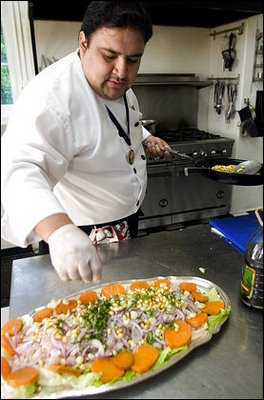
The Peruvian Embassy barman, Marcelino Lázaro (who has been shaking pisco sours at Embassy receptions and cocktail parties for the last 20 years) explained that the perfect pisco sour, depends on "the proportions." Nicholls concludes that the pisco sour, "like much of Peruvian cooking, packs a punch."
To read the complete article from the Washington Post, click here. (Registration may be required.)
Peru.Food@gmail.com
.
.
.
Prom Perú, the Peruvian Comission for the Promotion of Peru, has become keenly aware of the increasing role of Peruvian cuisine as a brand to be marketed, both home and abroad.
Along with the launch of the book Perú Mucho Gusto, Prom Perú has also developed a website discussing Peruvian cuisine in detail. From time to time, I will post portions of that website on this blog.
In the meantime, here are some pictures of some of the most well-known Peruvian dishes.
Enjoy!
What better way to start your meal than with a classic Peruvian ceviche?

If you are seeking something more exotic, perhaps the Amazonian dish juanes may tempt you. Reminiscent of a tamal, it is made with rice stuffed with chicken and hard-boiled egg cooked in a banana leaf.
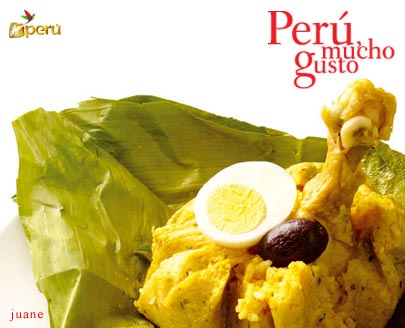
Almost any Peruvian restaurant in the world offers their variation of the coastal Peruvian and Asian fusion dish, lomo saltado.
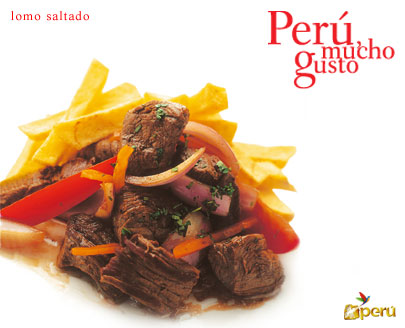
There is no more refreshing cocktail to accompany your meal than the classic pisco sour.
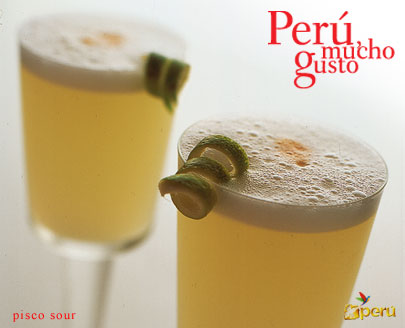
For dessert, the sweet suspiro limeño is perfect ending to a delicious Peruvian meal.
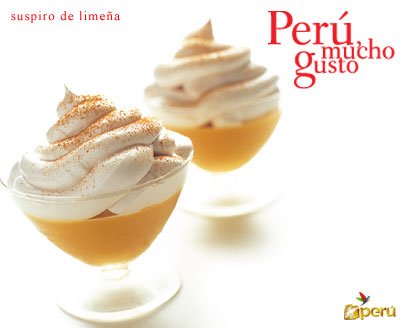
All pictures from Perú Mucho Gusto.
To read a previous post about Perú Mucho Gusto, click here.
Peru.Food@gmail.com
.
.
.
The Peruvian government continues its support of Peruvian cuisine.
Prom Perú, the government tourism board, announced the publication of a new book, Perú Mucho Gusto, profiling 70 top Peruvian chefs, including, among others, Teresa Izquierdo, owner of the renowned cocina criolla restaurant Rincón Que No Conoces, and Eladio Espinoza, a master in the preparation of shrimp at his restaurant, San Isidro.
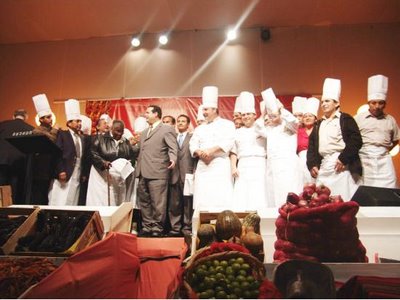
The book also includes recipes featuring the gastronomic diversity of Peruvian cuisine. During the book's launch party, at Plaza Bolivar in the Lima district of Pueblo Libre, many of the featured chefs were present.

For an article in Spanish about this event, please click here. Photos from: Radio Programas del Perú.
For a post featuring some of the superb photos from Perú Mucho Gusto, click here.
Peru.Food@gmail.com
.
.
.
Cucho La Rosa, one of the deans of the Peruvian kitchen, recently opened a new restaurant located in Pachacámac, south of Lima.
Don Cucho's restaurant is located in a colonial hacienda named Casa Blanca.
Just half an hour from Lima, Casa Blanca is easily reached by heading on the southbound Panamericana Sur, past the bustling and popular district of Villa El Salvador. Once you reach the pre-Columbian temple of Pachacámac (well-worth a visit; for millennia, it was a site of pilgrimage from throughout the Central Andean world), you turn onto the old highway, Antigua Panamericana Sur. At Avenida Manuel Valle, you turn inland towards the Andes, winding along the fertile Lurín River Valley, right past Pachacámac village. From there, follow the signs to the Antigua Hacienda Casa Blanca.
 Cucho La Rosa displaying his renowned lomo saltado al pisco.
Cucho La Rosa displaying his renowned lomo saltado al pisco.
Photo: Consuelo Vargas, El Comercio, 05/12/06.
Country Lunch In Pachacámac
El Comercio, 05/12/06
For original article, click here.
Don Cucho La Rosa has moved.
He's taken his pots and pans, his mortars and pestles, his ajíes and his onions. Fortunately, he hasn't gone too far from Lima.
Cucho La Rosa is now found in a splendid colonial hacienda, the Casa Blanca, which is located on 5,000 square meters at the far end of Pachacámac district.
This is where don Cucho is now cooking.
His interpretation of home-style Peruvian criollo cuisine is his gift to us. It is what the people demand, and he complies, offering us causa limeña, chicken escabeche, ceviche, lomo saltado, carapulcra, ají de gallina, veal seco with red frejoles, pachamanca for one with osso buco and chicken, cuy chicharrón in a spicy sauce, and the crown jewel of seafood soups, shrimp chupe.
The delicacies he prepares are best accompanied by a refreshing pisco sour.
Cucho confesses his new restaurant has been conceived as a place where the entire family can arrive and enjoy traditional Peruvian cuisine, a place where people spend the day in the sun and countryside.
His is a true country-style restaurant. Very comfortable, it offers various dining areas and terraces surrounded by beautiful gardens. Prices are fair and geared to Peruvians with a demanding palate. The median price per dish is 25 soles.
Read a more recent post about La Casa de Don Cucho here.
Antigua Hacienda Casa Blanca
Calle 8 Lote 14-A
Pachacámac
Open Tuesday to Sunday, lunch and dinner.
Closed Monday.
Reservations: 231-1415, 9920-6219
Peru.Food@gmail.com
.
.
.
After a temporary absence, I am glad to be blogging again about one of my favorite topics, Peruvian cuisine.
The article below (translated from the Spanish) was written by Luís Arriola, and published last year in the La República newspaper.
Callao, the port of Lima, like many port districts worldwide, is both historic and seedy, charming yet dangerous. There are architectural and culinary treasures to be found in el Callao, but caution needs to be exercised when visiting. Please be sure to take a secure taxi when dining at any of the well-known establishments below.
La Punta, just beyond el Callao, is located on a sliver of land bordered on three sides by the Pacific Ocean and with commanding views of the arid island of San Lorenzo, just off the coast. La Punta was a fashionable retreat of Lima's well-to-do in the 20th century, and there are wonderful neo-classical and Art Deco mansions that line the malecón, or seaside promenade. La Punta still is home to middle-class, or even wealthy, people, but care should be taken going and returning from there. Once again, a secure taxi is the best option.
Please be sure to visit these districts only during daylight. In fact, the restaurants listed below are mostly open just for lunch. Prices are very reasonable at all of the restaurants listed below.
My cautionary words are not meant to be off-putting; rather, to make sure that your culinary experience is not marred by any unpleasantness.
The author of this article discusses huariques (wa-ree-kehs) a Peruvian expression which refers to very traditional, small, family-run establishments known for the excellence of their cuisine.
Eating Well in el Callao
by Luís Arriola, La República (03/05/05)
In Callao's most traditional neighborhoods, there are small restaurants that offer delicious food. Among them are Mateo, Rovira, Manolo, and Marina, all of which offer unique seafood-based dishes. Diners visit these restaurants religiously.
Since Callao is a port, its cuisine is linked to the sea. Fish, crab, mussels, and all other types of varied seafood are prevalent. This abundance of marine life is the basis for the succulent gastronomic offer, for which Callao is famous.
There is no better way to prove the existence of these delicacies than by visiting the huariques known best to the culinary cognoscenti. The multiple varieties of ceviches and tiraditos will satisfy the appetite of the most exacting diner.
These huariques are family-run businesses that delight the most demanding palates. According to the Dictionary of the Royal Academy of the Spanish Language (published in Spain), the term huarique is a Peruvianism that means, 'a hiding place'; that is, 'a place in which to hide, or in which to hide something.
Chef Gastón Acurio defines the term huarique as a small, secret place, a family-run establishment where diners share fine food, and the art of fine dining comes above all else.
He explains, "These are families dedicated to cooking, who have become specialists in one or two signature dishes. The quality of their food is as fine as any found in a five-star restaurant, with the difference being the price, and in some huariques, you can even ask for second helpings."
The chefs in Callao's huariques are self-taught. Using local ingredients and with no lack of imagination, they create dishes not found elsewhere. In Callao, you can find dishes such as tiradito in three flavors, or mango ceviche, or tasty seafood sandwiches, among others. These well-known huariques in el Callao listed below, are places that anyone who seeks good food should know.
 Top: Mateo in Callao.Middle: Ceviche de Mango at Manolo.Bottom: Enjoying seafood at a local huarique.(Photos: La República, 03/05/05)
Top: Mateo in Callao.Middle: Ceviche de Mango at Manolo.Bottom: Enjoying seafood at a local huarique.(Photos: La República, 03/05/05)
Mateo
There isn't a chalaco (as the natives of Callao are called) who has not eaten at Mateo, located in the historic center of Callao.
In Mateo, the specialties are first-rate fish and seafood.
The restaurant is named after its owner, Mateo Rojas Huayta. Every day of the year, from 8 a.m. until 7 p.m., this restaurant opens its doors at Jirón Miller 386, next to the main church in Callao.
Among the most special dishes served here is the tiradito in three flavors. This dish is a piece of fish cut into fine slices and divided in three parts. The first part is covered in a creamy ají amarillo sauce, the second in a white sauce made with parmesan cheese and cream, and the third in a creamy rocoto sauce. Each sauce is a different color, hence the name.
"Our menu says this is a dish for one," tells don Mateo, "but, two or even three people can easily share it."
Another specialty of the house is the seafood soup pariahuela a lo Mateo, which can include chita, or tramboyo fish, a whole crab, and other shellfish. Alluding to the aphrodisiacal qualities of seafood, don Mateo laughs and says, "This dish has been responsible for many clients and workers of mine having twins."
Don Mateo arrived in Callao years ago from his native Ayacucho. About 25 years ago, he decided to open a bar at his current location. To entice his customers, he began to offer traditional seafood dishes like choritos a la chalaca, escabeche and mussel soup.
Soon, people began to ask him to expand his menu, and he decided to take some cooking courses to learn to make new dishes. "The only way to move forward in life is by learning new things," concludes don Mateo.
Restaurante Mateo
Jirón Miller 386
Callao
Note: Specialties include tiradito en tres sabores, parihuela a lo Mateo, and orgía de mariscos. These dishes are incomparable. Dishes are for one, but two can easily share one. The presentation is very good, as is the pisco sour.
Bar Restaurant Rovira
There are so many restaurants offering excellent fish and seafood in Lima, clients have become very demanding. The owners of Bar Restaurant Rovira know this and their dedication is probably why this establishment in Callao has been in business for the last 97 years at the same location, Jirón Daniel Nieto 195, in the historic center of Callao and very close to the Real Felipe fortres.
The current administrator, Alejandro Chuquimango, has been working there for the last 36 years. He began as a waiter and rose up through the ranks.
Owner Miguel Rovira is the inventor of the pejerrey fish sandwiches, anchovy appetizers, and mussel soup. Among many of the succulent dishes found on the menu is the tasty and spicy seafood picante and delicious one-pot stews.
This welcoming restaurant has fed mayors, presidents, and other members of the Peruvian elite for almost a century.
Rovira is world-famous. Both locals and foreigners come to sample our sandwiches," states don Miguel.
Apart from its culinary specialties, the Rovira is ensconced in an architectural jewel. The original floors are over 100 years old. As you enter, the small tiles, worn and discolored with age, gently descend towards the center of the restaurant, where another wood floor gently rises. Simply put, the floor of Rovira undulates like a gentle ocean wave.
Because of this floor many of our clients say the restaurant has two sections: Perla Baja and Perla Alta. When they come, they tell us in which section they wish to eat," explains Alejandro Chuquimango. Some of the tables and chairs are as old as the restaurant itself. Many customers enjoy eating their sandwiches seated on hundred-year old seats.
Bar Restaurant Rovira
Jirón Daniel Nieto 195
Callao
Note: Specialties include the pejerrey sandwich, mussel soup, and choritos a la chalaca (mussels in the style of Callao). Specialty cocktails include Sol y Sombra.
Manolo
"I have a friend who always says: 'This is as bad as a mango ceviche'. And one day, to play with him, I made him a ceviche with mango, which he liked, and since then for the past five years, I prepare this dish, here at Manolo, in La Punta."
This is how Manuel Herrera Monasí explains the origin of this singular specialty in his welcoming locale.
For the past 12 years, this restaurant has been open along Malecón Pardo in La Punta. During all these years, there has been no lack of skeptics who have come to eat at Manolo simply to challenge the chef, not believing the most traditional of Peruvian seafood dishes, ceviche, could be made with mango. They even place bets, with losers paying the bill. Don Manuel explains the dish is not ceviche with mango, but a mango ceviche, which has a, "unique sweet-and-sour flavor."
The dish is prepared in the classic ceviche manner, but instead of being made with fish, it is made with slices of mango, and served alongside the requisite boiled corn, lettuce, onion, parsley, and ají limo.
There are only nine tables in the restaurant, and the don Manuel says he doesn't want any more. "We don't hire people to stand outside our restaurant and draw people in by yelling out our specialties. People come because they know me and how good my cuisine is. Whoever wants to come in, is welcome to do so," he affirms.
Manolo is open daily from midday until 5 p.m. It is only closed on Christmas Day and Good Friday. Don Manuel has lived in La Punta for 55 years.
When customers ask don Manuel to recommend a specialty, he always responds he can't because, "taste is so subjective. I just tell them that everything on the menu is completely authentic."
El Manolo
Malecón Pardo, module 1-N
La Punta
Note: Other specialties include a mushroom ceviche and asparagus vinaigrette.
Restaurant Marina
Marina Wong Kuoman was taught by her father since girlhood to prepare wontons and fried rice every weekend. It was her mother, who specialized in Peruvian criollo cuisine, who influenced Marina to mix the flavors of traditional Peruvian coastal dishes with the taste of the Orient.
At the onset, it seemed like a game, but then Marina, who is half Chinese and half Peruvian, realized that she had a culinary responsibility.
Since then, she has won several culinary contests, a cooking contest oraganized by a local university. "I prepared a dish called nido de mariscos, shellfish nest, made with Chinese noodles, shellfish, quail eggs, mushrooms, fried chuño, and as a base, a traditional causa criolla. I did it to prove something to myself, and I won," recalls doña Marina.
Another of her restaurant's specialties is octupus salad and kalu wonton with fried fish. This last dish is spectacular and requires patience and time to prepare.
She also offers more commonly-known dishes such as jalea and mixed ceviche, or seafood rice. "In order to marry criollo cuisine with Asian, I had to experiment in the kitchen. Also, as a descendant of Chinese people, I felt I had to leave my daughters and grandchildren a legacy," states doña Marina.
For the past 30 years, she has lived in La Punta, and 15 years ago she opened this restaurant which overlooks the Pacific, at Malecón Pardo, module 2.
Marina
Malecón Pardo, module 2
La Punta
Note: Most of the dishes are easily shared by two diners.
There are other huariques in El Callao. Notable among them is:
La Cabaña de Maguila
Agustín Tovar 182
La Punta
Open Monday to Sunday, 11:00 a.m. to 6:00 p.m.
Note: Among the specialties: sole ceviche a lo Maguila, octupus in olive oil, and, sole tiradito.
Peru.Food@gmail.com
.
.
.


